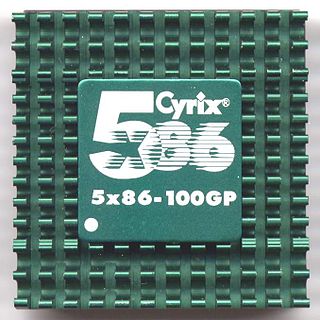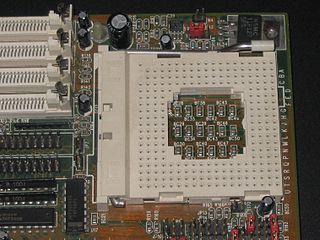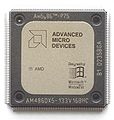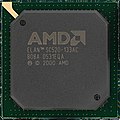
The Cyrix 6x86 is a line of sixth-generation, 32-bit x86 microprocessors designed and released by Cyrix in 1995. Cyrix, being a fabless company, had the chips manufactured by IBM and SGS-Thomson. The 6x86 was made as a direct competitor to Intel's Pentium microprocessor line, and was pin compatible.

The Intel 386, originally released as the 80386 and later renamed i386, was the first x86 32-bit microprocessor designed by Intel. Pre-production samples of the 386 were released to select developers in 1985, while mass production commenced in 1986. The processor was a significant evolution in the x86 architecture, extending a long line of processors that stretched back to the Intel 8008. The 386 was the central processing unit (CPU) of many workstations and high-end personal computers of the time. The 386 began to fall out of public use starting with the release of the i486 processor in 1989, while in embedded systems the 386 remained in widespread use until Intel finally discontinued it in 2007.

The Intel 486, officially named i486 and also known as 80486, is a microprocessor introduced in 1989. It is a higher-performance follow-up to the Intel 386. It represents the fourth generation of binary compatible CPUs following the 8086 of 1978, the Intel 80286 of 1982, and 1985's i386.

The K6 microprocessor was launched by AMD in 1997. The main advantage of this particular microprocessor is that it was designed to fit into existing desktop designs for Pentium-branded CPUs. It was marketed as a product that could perform as well as its Intel Pentium II equivalent but at a significantly lower price. The K6 had a considerable impact on the PC market and presented Intel with serious competition.

The Pentium is a microprocessor introduced by Intel on March 22, 1993. It is the first CPU using the Pentium brand. Considered the fifth generation in the x86 (8086) compatible line of processors, succeeding the i486, its implementation and microarchitecture was internally called P5.

Cyrix Corporation was a microprocessor developer that was founded in 1988 in Richardson, Texas, as a specialist supplier of floating point units for 286 and 386 microprocessors. The company was founded by Tom Brightman and Jerry Rogers.

The Pentium Pro is a sixth-generation x86 microprocessor developed and manufactured by Intel and introduced on November 1, 1995. It introduced the P6 microarchitecture and was originally intended to replace the original Pentium in a full range of applications. Later, it was reduced to a more narrow role as a server and high-end desktop processor. The Pentium Pro was also used in supercomputers, most notably ASCI Red, which used two Pentium Pro CPUs on each computing node and was the first computer to reach over one teraFLOPS in 1996, holding the number one spot in the TOP500 list from 1997 to 2000.

The Cyrix 5x86 is a line of x86 microprocessors designed by Cyrix and released on June 5 of 1995. Cyrix, being a fabless company, had the chips manufactured by IBM. The line came out about 5 months before the more famous Cyrix 6x86. The Cyrix 5x86 was one of the fastest CPUs ever produced for Socket 3 computer systems. With better performance in most applications than an Intel Pentium processor at 75 MHz, the Cyrix Cx5x86 filled a gap by providing a medium-performance processor option for 486 Socket 3 motherboards.
The PR system was a figure of merit developed by AMD, Cyrix, IBM Microelectronics and SGS-Thomson in the mid-1990s as a method of comparing their x86 processors to those of rival Intel. The idea was to consider instructions per cycle (IPC) in addition to the clock speed, so that the processors become comparable with Intel's Pentium that had a higher clock speed with overall lower IPC.
The Pentium OverDrive was a microprocessor marketing brand name used by Intel, to cover a variety of consumer upgrade products sold in the mid-1990s. It was originally released for 486 motherboards, and later some Pentium sockets. Intel dropped the brand, as it failed to appeal to corporate buyers, and discouraged new system sales.

Socket 7 is a physical and electrical specification for an x86-style CPU socket on a personal computer motherboard. It was released in June 1995. The socket supersedes the earlier Socket 5, and accepts P5 Pentium microprocessors manufactured by Intel, as well as compatibles made by Cyrix/IBM, AMD, IDT and others. Socket 7 was the only socket that supported a wide range of CPUs from different manufacturers and a wide range of speeds.

The Am486 is a 80486-class family of computer processors that was produced by AMD in the 1990s. Intel beat AMD to market by nearly four years, but AMD priced its 40 MHz 486 at or below Intel's price for a 33 MHz chip, offering about 20% better performance for the same price.
NexGen, Inc. was a private semiconductor company based in Milpitas, California, that designed x86 microprocessors until it was purchased by AMD in 1996. NexGen was a fabless design house that designed its chips but relied on other companies for production. NexGen's chips were produced by IBM's Microelectronics division in Burlington, Vermont alongside PowerPC and DRAM parts.

The K5 is AMD's first x86 processor to be developed entirely in-house. Introduced in March 1996, its primary competition was Intel's Pentium microprocessor. The K5 was an ambitious design, closer to a Pentium Pro than a Pentium regarding technical solutions and internal architecture. However, the final product was closer to the Pentium regarding performance, although faster clock-for-clock compared to the Pentium.

The Cyrix Cx486DLC is an x86 desktop microprocessor developed by Cyrix. It was Cyrix's second CPU offering, released years after selling math coprocessors that competed with Intel's units and offered better performance at a comparable or lower price. It was released in June of 1992, with a price of $119 for computer manufacturers.

Socket 3 was a series of CPU sockets for various x86 microprocessors. It was sometimes found alongside a secondary socket designed for a math coprocessor chip, such as the 487. Socket 3 resulted from Intel's creation of lower voltage microprocessors. An upgrade to Socket 2, it rearranged the pin layout. Socket 3 is compatible with 168-pin socket CPUs.

A compatibility card is an expansion card for computers that allows it to have hardware emulation with another device. While compatibility cards date back at least to the Apple II family, the majority of them were made for 16-bit computers, often to maintain compatibility with the IBM PC. The most popular of these were for Macintosh systems that allowed them to emulate Windows PCs via NuBus or PCI; Apple had released several such cards themselves.

The Cyrix Cx486 was an x86 microprocessor designed by Cyrix. It primarily competed with the Intel 486 with which it was software compatible, would operate in the same motherboards provided proper support by the BIOS was available and generally showed comparable performance. The chip also competed with parts from AMD and UMC.

The IBM ThinkPad 365 is a notebook computer series developed by IBM and manufactured by ASE Group. It was released in North America in November 1995, and was the successor of the ThinkPad 360 series. The series had eight models that were released before being discontinued, and was succeeded in 1997 by the ThinkPad 380 series.

The Packard Bell Statesman was an economy line of notebook-sized laptops introduced in 1993 by Packard Bell. They were slower in performance and lacked features compared to most competitor products, but they were lower in price. It was created in a collaboration between Packard Bell and Zenith Data Systems. The Statesman series was essentially a rebrand of Zenith Data Systems Z-Star 433 series, with the only notable difference of the logo in the middle and text on the front bezel.






















